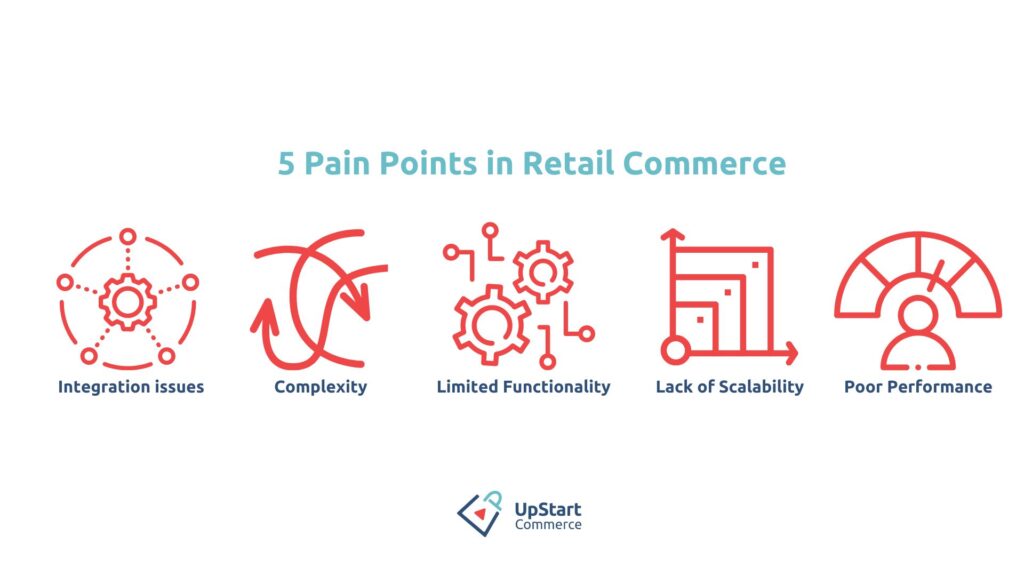Running a successful retail business requires navigating through various pain points. Whether you are an established retailer or a new player in the market, you are likely to encounter ecommerce pain points that can impact your growth. In this blog, we will discuss four pain points that retailers experience in their commerce operations. By identifying these challenges and understanding how to overcome them, you can optimize your operations, improve customer satisfaction, and drive growth in your business.

Ecommerce Integrations Issues
Retailers can face several integration issues with their platforms. Some of the common integration issues include:
- Compatibility issues
Retailers often use multiple platforms to manage their business operations, such as inventory management, order processing, and customer relationship management. These platforms may not be compatible with each other, leading to data synchronization issues and making it difficult for retailers to get a complete view of their business.
- Data integration
Retailers need to ensure that the data from different platforms is integrated and synchronized so that they can make informed decisions. However, integrating data from different platforms can be a complex process, especially if the platforms use different data formats or have different data structures.
- Technical issues
Technical issues can also arise during the integration process. For example, if the platforms have different APIs or use other programming languages, it can be challenging to integrate them.
- Security issues
Integrating multiple platforms can also increase the risk of security breaches. Retailers need to ensure that all platforms are secure and that data is transferred securely between them.
- Cost
Integrating platforms can be a costly process, as it may require hiring technical expertise or purchasing additional software or hardware.
Retailers may have difficulty integrating their commerce platform with other systems and software. This can lead to data inconsistencies and inefficiencies, as well as a lack of visibility and control.
Overall, retailers need to carefully evaluate their platform integration needs and develop a comprehensive plan to ensure that all platforms are integrated seamlessly and securely.
Complexity Issues
- User Experience
Retailers must provide a seamless and user-friendly experience to their customers across all platforms. Customers expect a unified experience on websites, mobile apps, and in stores. Creating and maintaining a positive user experience can be complex, requiring a deep understanding of customer needs and preferences.
- Scalability
As retailers grow, they need platforms that can handle the increased traffic and demand. The platform must be scalable enough to accommodate the growing needs of the business.
Limited Functionality
Retailers may find that their ecommerce platform does not have all of the functionality they need to effectively manage their business. Therefore their ability to grow and adapt to changing needs is limited. Here are some other issues that arise with limited functionality.
- User adoption
Certain functionalities may not be widely adopted by customers, which can limit their usefulness to retailers. For example, a platform feature that allows customers to rate and review products may not be practical if customers do not frequently use it.
- Platform restrictions
Some platforms may have restrictions on certain functionalities due to legal or regulatory requirements, limiting the options available to retailers. For example, platforms may have restrictions on how customer data can be collected or used. These restrictions can limit the effectiveness of certain marketing or personalization strategies.
Read More: Futureproof Your Retail Business With Microservice-Driven Platforms
Retailers may experience performance issues with their commerce platform or back office software, such as slow loading times or frequent crashes, which can lead to a poor user experience and lost sales. Here are some of the issues that retailers face commonly:
- Slow page loading times
If the website or mobile app takes too long to load, customers may become frustrated and leave the platform before making a purchase.
- Website crashes
Website crashes can happen due to various reasons, such as high traffic, server overload, or technical issues. A website crash can prevent customers from accessing the platform and completing purchases.
- Payment processing failures
Payment processing failures can occur due to technical issues or system errors, preventing customers from completing transactions.
- Inventory inaccuracies
When a platform does not accurately reflect the retailer’s inventory, customers may attempt to purchase items that are out of stock, leading to canceled orders and unhappy customers.
- Security breaches
If the platform experiences a security breach, customer data can be compromised, leading to loss of trust and damage to the retailer’s reputation.
- Poor search functionality
Inadequate search functionality leads to customers struggling to find the products they are looking for, leading to frustration and potentially lost sales.
- Inadequate customer support
If the retailer’s customer support is inadequate, customers may struggle to get the help they need to resolve issues. This can lead to dissatisfaction and potentially losing business.
Final Words
We started our company after years of dealing with these problems day in and day out. When we say built by retailers for retailers, we mean it. Retailers may encounter a range of problems with their commerce platforms and back office software. These problems include integration issues, complexity, limited functionality, lack of scalability, and poor performance. We designed and built our platform to make retailers’ lives easier. Our focus is on building data-driven tools that reduce the daily hours required to make your business outperform your competition.
